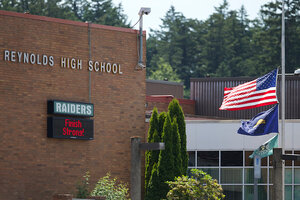When is a school shooting not a school shooting? Incident map stirs debate.
Following the homicide-suicide at a school in Oregon Tuesday, an alarming map of 74 US 'school shootings' since the Newtown massacre has sparked debate about which incidents should make the list.

Flags fly at half-staff Wednesday, June 11, 2014, at Reynolds High School in Troutdale, Ore.
Randy L. Rasmussen/The Oregonian/AP
In the wake of Tuesday’s homicide-suicide at a school in Troutdale, Ore., a list and map of 74 “school shootings” since the Newtown, Conn., massacre has made the rounds of traditional and social media this week.
Maintained by the group Everytown for Gun Safety – a coalition including Michael Bloomberg’s Mayors Against Illegal Guns – the list has stirred up a debate about what should count under the heading of school shootings. [See list here. See map here.]
The controversy exposes how politicized discussions of school safety have become. And it hints at how much the interpretation of numbers is in the eye of the beholder. Even the government and researchers can’t pin down with exact numbers or exhaustive lists how much violence occurs at schools.
On Everytown’s website, the list – by date, location, and whether it was on a K-12 or college campus – includes an explanation that it counts all incidents in which “a firearm was discharged inside a school building or on school or campus grounds, as documented in publicly reported news accounts. This includes assaults, homicides, suicides, and accidental shootings.”
“When gun violence enters into a school and a community, it really impacts that community,” says Everytown spokesperson Stacey Radnor.
But some news reports jumped on the number without detailing the criteria. And some say the criteria are too broad.
“When people think ‘school shooting,’ it’s Sandy Hook, it’s Columbine – it’s not a gang-banger actually shooting herself in the thigh,” says freelance journalist and data analyst Charles C. Johnson, who posted a series of links on his twitter feed @ChuckCJohnson with the heading, “Another fake shooting listed by everytown,” to point out all the incidents on the list that didn’t match people’s typical image of a school attack.
One of his tweets mentions a 19-year-old who was shot behind an elementary school building at night. This didn’t threaten school children during the day. But the ABC7News story he links to about the San Leandro, Calif., incident also illustrates Everytown’s argument about the impact of gun violence: “Classes were canceled … to give investigators time to gather any evidence that might be in the field during daylight hours. ‘We don't expect something like that to happen at school, and not at the night time; it's supposed to be closed, safe for the kids,’ parent Veronica Navarro said.” The victim was a student at a nearby college.
Another of Mr. Johnson’s tweets links to a story about an incident not even on the group’s list – about a June 2013 drug-related shooting near Morehouse College in Atlanta. But Everytown lists a Feb. 2013 incident at Morehouse, in which a student was shot on campus, with an estimated 20 witnesses, according to this local news report.
When contacted by the Monitor, Johnson acknowledged that he may have made some mistakes in cross-referencing stories about various instances, but said his overall point was to get people to examine the statistics.
CNN weighed in Wednesday, saying that 15 of the incidents on Everytown’s list bore similarities to the violence in Newtown and Oregon.
Everytown responded in a statement, noting that CNN itself had reported on at least eight of the 60 remaining incidents from Everytown’s list and had referred to them as school or college shootings.
In a February report, Everytown offered pages of details analyzing the incidents it had listed to that point, showing details such as the ages of the shooters and the fact that 49 percent had resulted in at least one death.
“If you are really interested in, ‘What is the likelihood of my child getting shot in school?’ you might be less interested in the suicides and shootings which occurred when most students weren’t around,” says David Hemenway, a Harvard health policy professor who studies gun violence.
But for people interested in the broader implications of gun violence, he says, “there’s a lot of evidence that if you … see someone shot, it’s incredibly traumatic… And as a parent I would be concerned about gun accidents if a kid brings a gun to school…. Seeing a suicide in school or seeing a teacher shot by her ex-husband, that’s traumatic.”
Students who experience trauma can be at-risk for various problems. And students who are aware of a suicide by a schoolmate are at heightened risk for suicidal thoughts themselves, research has shown.
Parents, educators, and the public have to think carefully about the agenda behind messages they hear about school shootings, says Kenneth Trump, president of National School Safety and Security Service. Federal reports underestimate the amount of school violence, while public perception overestimates it, and the reality is somewhere in between, Mr. Trump says.
Given that caveat, here are some tidbits to help put school violence in perspective:
• Between 14 and 34 school-age children are victims of homicide on school grounds or on their way to or from school in a given year, according to the Centers for Disease Control (CDC) School Associated Violent Death Study, based on data from 1992 to 2010. These represent 1 to 2 percent of all homicides of those ages 5 to 18.
• 6.9 percent of students were threatened or injured with a weapon (e.g., a gun, knife, or club) on school property during the previous 12 months, according to the 2013 National Youth Risk Behavior Survey. And 5.2 percent of students reported having carried a weapon at school, down from nearly 12 percent in 1993.

